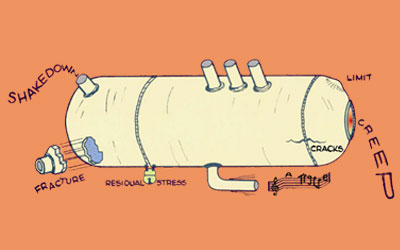If we come back in time, Pressure Vessels led to the biggest discoveries in engineering like steam boilers for example, but pressure vessels also caused a lot of problems. In 1905, a disastrous boiler explosion occurred in a shoe factory in Brockton, Massachusetts and killed 58 people, injuring 117 others and causing a quarter million dollars in property damage.

This is from that time that the decision to implement a code to formulate rules and regulations for Pressure Vessel Design have been formulated. The first edition of the ASME Rules for construction of Stationary Boilers and For Allowable Working Pressures, known as the 1914 edition, was adopted in the spring of 1915.
Before 1963, all Pressure Vessels were designed using a systematic Design by Formula Approach which was based on experience and simple mechanics. What was mostly described was how to keep hoop stress low with respect to yield and how to use ductile material to accommodate local peak stresses.
In the Design by formula, the vessel geometry and major dimensions such as radius, length, etc. are specified and the required thickness is then calculated for a given load using equations and graphical data.
With the development of the nuclear technology in the 1950s, pressure vessel design requirements needed to be improved in order to permit the use of higher allowable stresses without reduction in Safety.
This required to change the philosophy of Code design by formula. It is also worth to note that advances in mechanics theory and analysis methods provided new and more scientific methods for the pressure vessel design.
In 1963, ASME published the B&PV Code Section III: Nuclear Vessels based on the principles of limit analysis (Shakedown analysis, Fatigue Analysis) and Stress Analysis was used to determine higher allowable loads and more consistent margins of safety.
This improvement in the code permitted two approaches for design:
- Improved design by formula, providing more accurate formulae for sizing common components and higher allowable stresses, was intended for standard configurations
- Design by Analysis, in which designer performs stress analysis and evaluates results against code limits, was intended for configurations not covered by the Design By Formula
The ASME III Approach has influenced all other codes including the ASME VIII Division 2: Alternative rules for pressure vessels, the BS5500 Annex A and the EN 13445 Annex B & C Design by Analysis
PD5500 Annex A suggests that DBA (Design by Analysis) is used specifically for vessels outside the DBF remit but does not explicitly state the procedures cannot be applied to vessels covered by DBF
EN 13445 Annex B.1 and C.1 suggest that Design by Analysis may be used as an alternative to design formulas or as a compliment.
ASME VIII specifies that Design by Analysis applies to non-standard configurations while the thickness of elements of the vessel covered by DBF rules must meet Design By Formula minimum thickness requirements.
The main guidelines of the Design by Analysis are to prevent the gross plastic deformation or ductile burst under static load, the incremental plastic collapse under repeated or cyclic load and the fatigue under cyclic load. Elastic buckling, creep, brittle fracture, stress corrosion, etc. also have to be considered…
The new ASME Boiler & Pressure Vessel Code, Section VIII, Division 2 was published on July 1, 2007. This 2007 Edition became mandatory for vessel design in July, 2009. The new Section VIII, Division 2 Code includes a complete re-organization of the text, introduces a consistent and user-friendly format style, and provides a number of new and enhanced pressure vessel design procedures. Familiarity with the new organization and the application of these rules is essential to both the new and experienced vessel engineer to ensure proper vessel design.




Thank you for the post! It is really interesting to me to see how pressure vessel use has matured and become safer. You have to have a criteria to follow when dealing with the fabrication of pressure vessels, and you really laid out what that code is with this post! Thanks for making it so easy to get info on something that is not so often thought about such as pressure vessels!